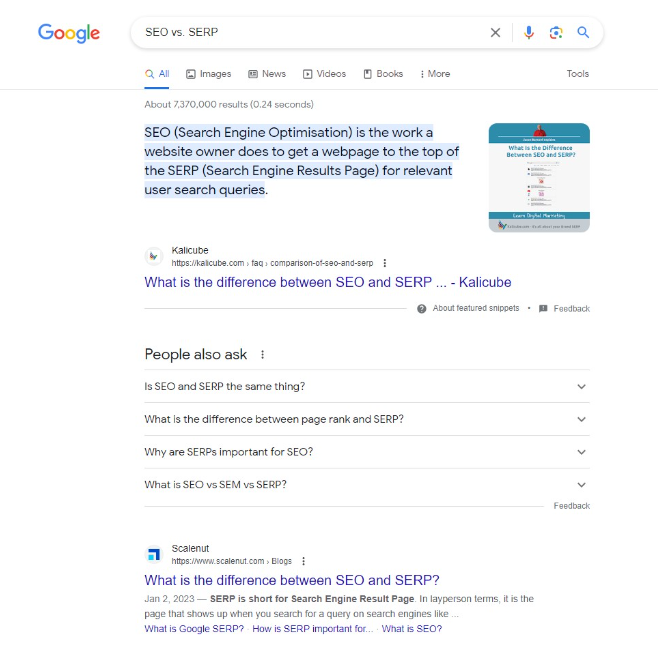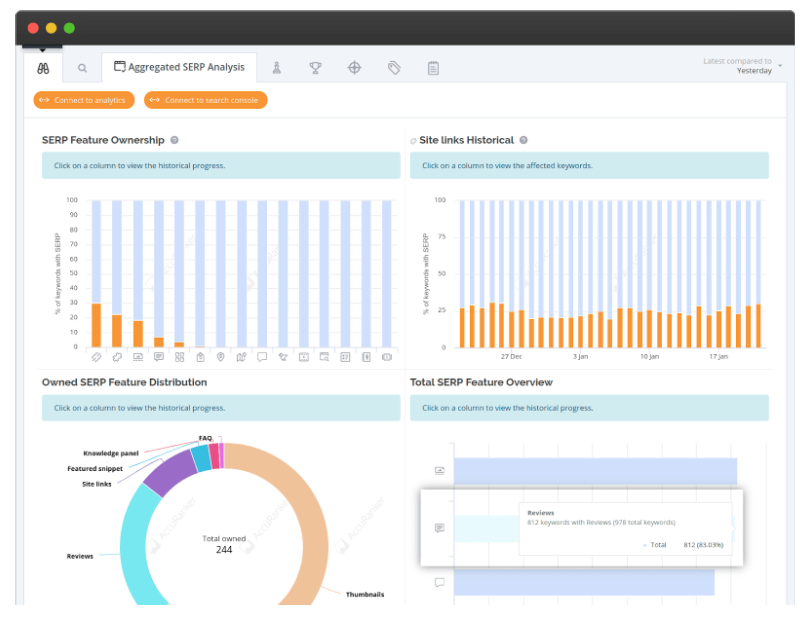
In the vast digital landscape, where the currency is attention and the prize is website traffic, the battle between SEO (search engine optimization) and SERP (search engine results page) unfolds. Navigating this dynamic terrain requires a nuanced understanding of these two powerful players and how they influence online visibility.
So, who will emerge victorious in the quest for your traffic? Let’s delve into the intricacies of SEO and SERP, exploring their individual strengths, collaborative potential, and the evolving dynamics that shape the battleground of the digital age.
The Dynamics of SEO
SEO is a cornerstone of the continuously transforming digital marketing landscape, a strategic discipline that has been remarkably changed since its inception. Initially perceived as a rigid set of rules to appease search engine algorithms, modern SEO has blossomed into a dynamic and adaptable strategy.
At its core, SEO encompasses a collection of techniques, all meticulously orchestrated to elevate a website’s prominence in SERPs. Compared to social media, SEO generates over 10 times more organic traffic.
Dispelling Myths and Embracing Change
Despite its transformative evolution, misconceptions about SEO continue to linger, hindering businesses from harnessing its true potential. To fully grasp the essence of modern SEO, it is imperative to dispel these myths and embrace the ever-changing landscape of digital search. Here’s a concise breakdown of key considerations:
- Keyword Optimization: The strategic selection and placement of relevant keywords throughout a website’s content, ensuring that it aligns with user search queries.
- Backlink Building: The process of acquiring links from other websites to your own, which serve as a testament to your website’s credibility and authority.
- Technical Site Improvements: Optimizing the technical aspects of a website, such as page loading speed and mobile-friendliness, to enhance user experience and search engine crawlability.
Unpacking SERP

A sample SERP
In digital search, SERP is the gateway to information, a dynamic landscape where users embark on their quest for knowledge. It is a carefully curated canvas, meticulously crafted by intricate algorithms that govern the hierarchy of displayed results. Understanding the anatomy of a SERP is akin to deciphering a complex code, revealing the ranking factors determining which websites earn coveted spots on the first page.
Demystifying SERP Dynamics
As search algorithms continuously evolve, staying abreast of SERP dynamics is paramount for businesses seeking to navigate the ever-changing landscape of digital visibility. To effectively optimize their websites for SERP success, businesses must delve into the intricacies of search engine ranking factors:
- Relevance: The alignment of a website’s content with the user’s search intent, ensuring it provides valuable and relevant information. Google says relevant online searches influence the buying choices of almost 40% of shoppers.
- Authority: A website’s reputation and credibility are measured by backlinks and domain authority.
- Technical Optimization: The technical aspects of a website, including page loading speed, mobile-friendliness, and structured data, influence user experience and search engine crawlability.
- User Engagement Metrics: The level of interaction users have with a website, such as time spent on a page, bounce rate, and click-through rates, which indicate content quality.
The Symbiosis: SEO and SERP Working in Tandem
Contrary to the perception of SEO and SERP as adversaries, they are symbiotic partners collaborating to shape the online visibility of a website. Effective SEO strategies directly contribute to improved SERP performance, ensuring that websites occupy prominent positions in search results.
Numerous case studies of successful integration highlight the significance of aligning SEO efforts with the practicalities of SERP. When these two entities work together, a powerful synergy is created, propelling websites to the forefront of search results.
The Strategic Harmony of SEO and SERP
To achieve optimal online visibility, businesses must recognize the strategic harmony between SEO and SERP. Here’s a breakdown of their symbiotic relationship:
- SEO as the Architect: SEO meticulously crafts strategies to optimize websites, ensuring they align with search engine algorithms and user intent.
- SERP as the Showcase: SERP serves as the public manifestation of SEO’s efforts, presenting the fruits of SEO’s labor to users.
The interplay between SEO and SERP is a continuous cycle of optimization and evaluation. SEO strategies drive website improvements, which in turn influence SERP rankings. SERP feedback, in turn, informs SEO strategies, leading to further refinements. This dynamic dance between SEO and SERP is crucial for businesses seeking to maintain a strong online presence.
Localizing the Battle: The Role of Local SEO and Local SERP
The digital duel between SEO and SERP extends beyond the global arena, reaching into the localized realm of local searches. For businesses catering to specific geographic audiences, the battlefield shifts to local SERPs, where the fight for visibility takes on a more granular and targeted approach. Local SEO is the driving force behind local SERP rankings, determining whether a business appears near potential customers searching for their products or services.

(Source: Semrush)
Strategies for Local SERP Dominance
In the localized landscape of local SEO, businesses must adopt a strategic approach tailored to their target audience’s specific needs and preferences. Here’s a breakdown of key considerations for local SERP dominance:
- Ensure your business is accurately listed on local directories, maps, and search engines, including Google My Business, Bing Places for Business, and Apple Maps.
- Tailor your website content to reflect your local audience, incorporating relevant keywords, phrases, and geographic references.
- Acquire backlinks from reputable local websites, such as community organizations, local news outlets, and relevant industry blogs.
- Encourage and respond to online reviews from customers, both positive and negative, demonstrating your commitment to customer service.
- Continuously monitor your local SERP ranking, adapting your strategies based on changes in search algorithms and user behavior.
Deciphering User Intent: A Game-Changer in SEO-SERP Dynamics
Deciphering user intent is not a one-size-fits-all endeavor. It requires businesses to adopt a nuanced approach, understanding the varying levels of intent behind different search queries. For instance, a user searching for “best game design schools near me” is likely seeking navigational intent, while a user querying “how to make a cake” harbors informational intent.
By aligning their content with these varying levels of intent, businesses can create a seamless user experience, ensuring that their SERP presence resonates with users and drives engagement. This strategic approach improves SEO performance and fosters trust and loyalty among potential customers.
Key Strategies for Deciphering User Intent
Effectively deciphering user intent requires data analysis, empathetic understanding, and creative problem-solving. Here’s a breakdown of key strategies:
- Utilize search query data to identify common keywords, phrases, and patterns in user searches.
- Differentiate between navigational, informational, transactional, and commercial search intent.
- Leverage specialized tools like AccuRanker to gain insights into user intent and search behavior.
- Create high-quality, informative, and engaging content that aligns with user expectations.
- Continuously monitor user behavior and adapt content strategies based on evolving search patterns.
Tools of the Trade: SEO Analytics and SERP Monitoring

In the arsenal of digital marketers, SEO tools and analytics play a pivotal role. These tools provide insights into website performance, allowing businesses to monitor and optimize for success on SERPs.
By leveraging these tools and the wealth of data they provide, businesses can gain valuable insights into their website’s performance, identify areas for improvement, and optimize their SEO strategies for maximum impact. Here are some key ways to harness data-driven insights for SEO success:
- Monitor your website’s ranking for relevant keywords to identify areas where you may need to adjust your content or SEO strategies.
- Understand your competitors’ strengths and weaknesses to identify opportunities to differentiate your website and gain a competitive edge.
- Use robust rank-tracking platforms like AccuRanker to track your website’s position for many keywords, providing comprehensive data-driven insights.
Use tools like Screaming Frog to identify technical issues hindering your website’s crawl ability and search engine ranking. - Utilize keyword research tools to optimize your website’s content, meta descriptions, and title tags.
- Keep an eye on the evolving SERP landscape and adapt your strategies to optimize for featured snippets, rich snippets, and other features.
Content Reigns Supreme: SEO Content vs. SERP Appeal
Amidst the technicalities of SEO and SERP, one constant remains: content reigns supreme. While technical SEO plays a crucial role in ranking websites, the quality of content ultimately determines whether users engage with and find value in a website. Optimizing content is not merely a checkbox on an SEO checklist; it is the foundation for a website’s success.
The art of creating effective SEO content lies in striking the delicate balance between optimization and user engagement. Content must align with search engine algorithms and resonate with the target audience, providing valuable information and addressing their needs. When this balance is achieved, content becomes discoverable but also compelling and engaging.
To create SEO content that resonates on SERPs, businesses should adhere to these key principles:
- Strategically incorporate relevant keywords throughout the content, ensuring it aligns with user search queries.
- Prioritize high-quality, informative, and engaging content that provides value to the target audience.
- Organize content clearly and easily, using headings, subheadings, and bullet points for optimal readability.
- Produce content of appropriate length, catering to the specific search intent of the target audience.
- Regularly update and refresh content to maintain relevance and attract search engines.
Beyond the Duel: Orchestrating Harmony for SEO-SERP Supremacy
In the ever-evolving quest for online traffic, the battle between SEO and SERP continues to shape the digital landscape. As businesses navigate this dynamic terrain, the key lies in recognizing the symbiotic relationship between SEO and SERP. Rather than pitting these entities against each other, companies strategically aligning their efforts will emerge as the true victors in the battle for online visibility and user attention. The future beckons and those who master the delicate dance between SEO and SERP will undoubtedly lead the charge into the next era of digital dominance.





